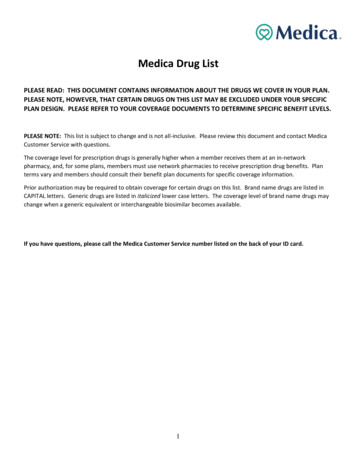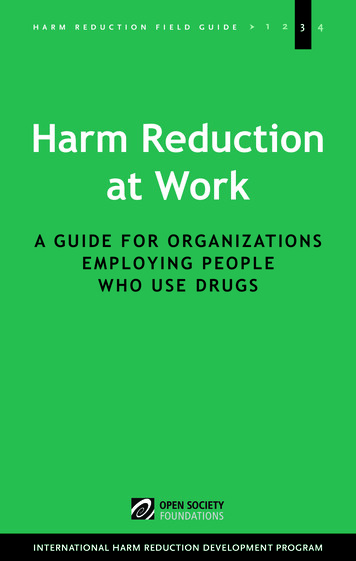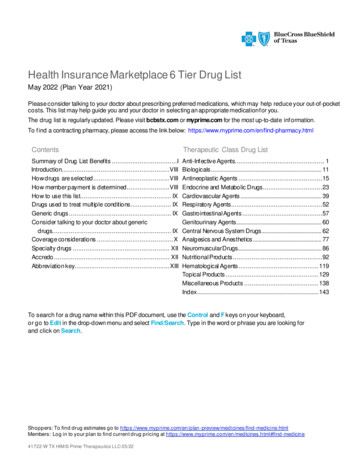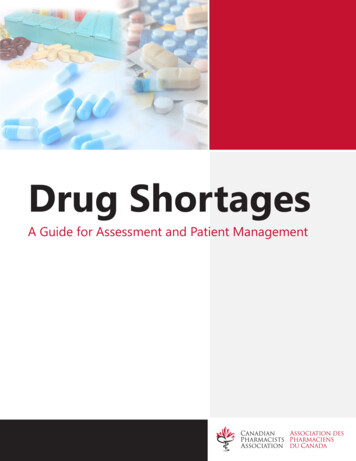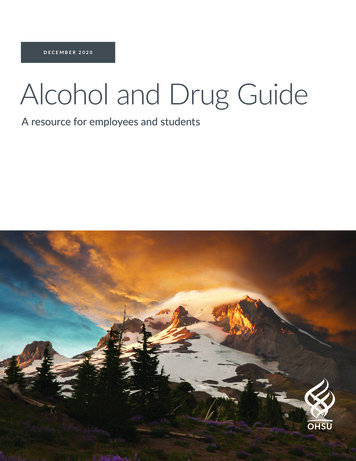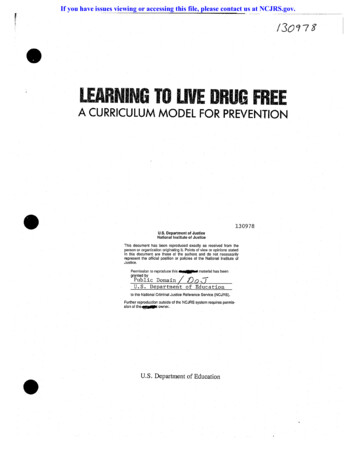
Transcription
If you have issues viewing or accessing this file, please contact us at NCJRS.gov.LEARNING TO LIVE DRUG FREEA CURRICULUM MODEL FOR PREVENTION130978U.S. Department of JusticeNational Institute of JusticeThis document has been reproduced exactly as received from theperson or organization originating it. Points of view or opinions stat:din this document are those of the authors and do not necessarilyrepresent the official position or policies of the National Institute ofJustice.Permission to reproduce this ald material has beengranted by/Public DomainQ , )u. S.DDepartmerit of Educationto the National Criminal Justice Reference Service (NCJRS).Further reproduction outside of the NCJRS system requires permission of the owner.u.s. Department of Education
Special Thanks To .Charles H. Flatter and Kathleen McCormick, principal authors of this curriculum model.Lesson plans in Part IV, pages 9, 11, 12, 18, and in Part V, pages 16 and 18 were developed bythe Texas Education Agency (TEA) as part of its project "Education for Self-Responsibility II:Prevention of Drug Use" and have been included with the permission of the TEA.Lesson plans in Part IV, pg. 21 and Part V, pages 10, 13, 15, 17, and 21 were developed by theUniversity of California, Irvine PACT Project, 1988, under a grant from the U.S. Departmentof Education. These plans may be reproduced for nonprofit, educational purposes only.AIDS information in Part VI, pages 3 and 4, is adapted from Reducing the Risk: A School Leader'sGuide to AIDS Education, 1989 by the National School Boards Association (NSBA) and hasbeen included with the permission of the NSBA. The material may be reproduced for nonprofit,.educational purposes only.We Wanl To Hear From YOUII Please send your comments about this curriculum and any samples of locally developed lessonplans you wish to suggest to include in future revisions to the following address:National Clearinghouse for Alcohol and Drug InformationDepartment CP1Box 2345Rockville, MD 20852ii
UNITED STATES DEPARTMENT OF EDUCATIONTHE SECRETARYMay 1990Dear Colleague:Education is a powerful weapon in the war on drugs. Each school,each community, each home has a vital role to play in helpingyoung people remain drug free.As Secretary of Education, one of my priorities has been toensure that the Nation's schools are provided with up-to-date,accurate information, both printed and audiovisual materials, toreinforce local prevention efforts.In keeping with that commitment, I am pleased to present thisdrug prevention curriculum model for your consideration and use.In it you will find information on the stages of childdevelopment as they relate to drug prevention, facts about drugs,suggested lesson plans, tips on working with parents and thecommunity, and a resource section for further information.This curriculum model has been designed to provide a flexibleframework for classroom-based prevention efforts in kindergartenthrough grade 12. I encourage you to read the document in itsentirety to see how the lesson plans and grade clusterinformation complement and build on each other.Schools areencouraged to revise, adapt, or integrate the model to meet theirneeds. Schools that do not have a prevention curriculum maychoose to use Learning to Live Drug Free as their primaryprevention resource. Schools that do have a program may chooseto use the information and lessons in this curriculum model tosupplement other efforts.Although the Department does not prescribe curricula, I hope thatLearning to Live Drug Free will become a vehicle to tap thecreativity and knowledge of successful drug prevention strategiesin our Nation's schools. Your comments and suggestions forimprovements are welcome.I encourage you to submit your ownlocally developed lesson plans for possible inclusion in futurerevisions of the curriculum model.400 MARYLAND AVE., S.W. WASHINGTON, D.C. 20202-0100
Page 2 - Dear Colleaguecurriculum alone cannot hope to solve the problems of drug use byour youth. A curriculum is only one part of what must be acomprehensive, coordinated plan of attack on drug use thatenlists the aid of all segments of the community. Thiscurriculum model is only a beginning.I hope it will also be acatalyst to expand and invigorate our mutual efforts to achieveschools without drugs.Sincerely,; "6.,c: Lauro F. Cavazos
ConlentsLetter From the Secretary . iiiPart I: IntroductionThe Role of Prevention . . . . . . . . . . . . . . . . . . . . . . . . . . . . . . . . . . . . . . . . . . . . . . . . . . . . . .How To Use the Curriculum Model .Identifying Students at Risk For Drug Use .Integrating Curricula and Materials .Guidelines For Curriculum Presentation .Evaluation .134567Part II: Kindergarten Through Grade 3Background For Teachers .Facts About Alcohol and Other Drugs .Working With Parents . . . . . . . . . . . . . . . . . . . . . . . . . . . . . . . . . . . . . . . . . . . . . . . . . . . . . . . . . .Working With the Community .Lesson Plans and Activities .13456Part III : Grades 4-6Background For Teachers .Facts About Alcohol and Other Drugs .Working With Parents . . . . . . . . . . . . . . . . . . . . . . . . . . . . . . . . . . . . . . . . . . . . . . . . . . . . . . . . . .Working With the Community .Lesson Plans and Activities .13568Part IV: Grades 7-8Background For Teachers .Facts About Alcohol and Other Drugs .Working With Parents . . . . . . . . . . . . . . . . . . . . . . . . . . . . . . . . . . . . . . . . . . . . . . . . . . . . . . . . . .Working With the Community .Lesson Plans and Activities .13689Part V: Grades 9-12Background For Teachers .Facts About Alcohol and Other Drugs .Working With Parents . . . . . . . . . . . . . . . . . . . . . . . . . . . . . . . . . . . . . . . . . . . . . . . . . . . . . . . . . .Working With the Community .Lesson Plans and Activities .v13679
Part VI: ResourcesParental Consent Requirements .Parent-Child Communication Tips .Facts About AIDS . . . . . . . . . . . . . . . . . . . . . . . . . . . . . . . . . . . . . . . . . . . . . . . . . . . . . . . . . . . . .Signs of Drug Use . . . . . . . . . . . . . . . . . . . . . . . . . . . . . . . . . . . . . . . . . . . . . . . . . . . . . . . . . . . . .School and Community Resources . . . . . . . . . . . . . . . . . . . . . . . . . . . . . . . . . . . . . . . . . . . . .Sources of Information . "Specific Drugs and Their Effects .vi12356812
.--.-- -aI»5't:t. C":Ii i'::IPari IIntroduction
IntroductionThe Role of PreventionEducating young people about the hazards of alcohol and other drug use and arming them with skillsthat deter drug use is an important component of thenation's war against drugs. To combat student druguse most effectively, the entire community must beinvolved: parents, schools, students, law enforcement authorities, religious and community organizations. Each of these groups must unite behind aconsistent message that illegal drug use is wrongand harmful.Schools are uniquely situated to playa majorrole in prevention because young people spendmuch of their time in school and because schoolsare a major influence in transmitting appropriatestandards of behavior. Schools can contribute to thenational prevention efforts, not only by presentingaccurate information about drugs, but also by developing and enforcing firm, consistent policies thatdiscourage their use and sale. Further informationabout how to establish a comprehensive drug prevention program is contained in the Department ofEducation's publication What Works: Schools Without Drugs. Copies are available by calling the Department's toll-free number listed in the Resourcessection of this curriculum model.Although the use of some drugs by school-ageyouths has declined recently, drug use continues tobe a grave problem. Alcohol use, for example, continues at unacceptably high levels among highschool students, and in some communities, crackcocaine has drawn children into a deadly world ofdrug dealing and drug use. The nation faces an unprecedented assault by new drugs as well as drugsthat are significantly more powerful than thoseavailable 10 to 15 years ago. These drugs are affecting all segments of society.Only by working together-every school andevery community in the nation-can we teach ourchildren that drug use is dangerous, that it is not thenorm for youth, and that it destroys the fabric of ourdemocratic society.The purpose of the curriculum modelThis drug prevention curriculum model provides a framework for prevention education fromkindergarten through 12th grade. It provides the basics for starting or expanding drug education; it includes information about drugs, background forteachers on child growth and development, samplelesson plans and activities, and suggestions onworking with parents and the community. The format is expandable, so that school districts and individual classroom teachers can add or updateinformation-and create their own lesson plans andactivities.Written primarily for school teachers, administrators, and principals, the curriculum modelis also useful for health and social services professionals, parents, business leaders, and other peoplewho want to help prevent drug use among youth.The need for a curriculum modelAlthough some states already have developedcomprehensive drug prevention curricula, the majority have not. Some recommend that schools develop their own curricula using state guidelines orpurchase curricula developed by commercial publishers and nonprofit organizations.This curriculum model provides a nucleus ofinformation, background, and classroom activitiesthat schools need to begin teaching about drug prevention. It may also be used in conjunction withprevention materials schools may already be using.The curriculum model has as its foundation research on drug prevention education and familiaritywith what works in the classroom. Drug preventioneducation is an evolving field, and researchers, educators, and policymakers continue to debate the effectiveness of various approaches in changingstudents' knowledge, attitudes, and behavior. Because of this diversity of approaches, the curriculummodel provides a number of ways to work the drugprevention message into school and community life.The curriculum model philosophyThis curriculum model begins with the premisethat most youth do not use drugs. One of its primary purposes, therefore, is to enhance the development of life skills that keep youth from usingPart I-I
drugs. Although the curriculum model includes information about drugs and drug use, it focuses primarily on positive prevention messages: being drugfree is something to be proud of; building children'sacademic and life skills is an important drug prevention strategy; and providing appropriate adultguidance is n.ecessary so that youths will choose toparticipate in wholesome, healthy activities.The curriculum model is based on researchabout human growth and development. The modelexplores the link between normal child growth anddevelopment and the possibility of involvement withillegal drugs. It explains the susceptibility to drugsat various ages, and it provides the rationale for lessons and activities so that teachers and others willunderstand the importance of presenting specific information and helping build specific skills at various age levels.As part of this wider perspective on prevention, the curriculum model is built around the themeof responsibility, both individual and civic. Responsibility for self and others is an important component in developing a sense of community. Themodel provides lessons and activities designed tohelp students understand that they are an importantpart of the community, and that responsible behavior includes not using drugs and helping keep theircommunity drug free. The theme of responsibilityencourages the teaching of citizenship and idealsthat are central to our democracy, such as government by the people and working toward the goodof society.The curriculum model promotes discussionsabout how children develop and how children atvarious ages can best learn the prevention message.It provides a framework for various parts of the curriculum, especially classroom lessons and activitiesand parent and community involvement.In addition to teaching about responsibility, thecurriculum model emphasizes generally acceptedvalues-such as being honest, setting goals, helpingfriends, and exercising self-discipline-which encourage students to be caring and productive citizens. The lessons focus on activities that providestudents with the opportunity to reinforce the normof non drug use.Because of the role teachers have in impartingknowledge and because children spend so muchPart 1-2time with them, teachers can be important modelsof responsible, caring behavior. The power of suchpositive role models will be greatly magnified if every teacher makes a commitment to joining theschool drug prevention team.Infusing the prevention messageThe curriculum model introduces the drug prevention message into the general school cUlTiculumthrough a process by which teachers in a variety ofsubject areas present drug prevention lessons usingskills and information appropriate to their specificsubjects. An elementary school teacher, for example, might present a mathematics lesson on the costto society of illegal drugs. A seventh grade Englishteacher might use a lesson plan about Tom Sawyerto illustrate the influence of peer pressure and waysin which youths can resist drugs.Infusing the drug prevention message into a variety of subject areas has several purposes: First, themessage is more likely to have an effect if it is presented in different ways and in a variety of subjects,rather than, say, just in health class. Second, infusion reinforces the acquisition of specific academicskills. And third, infusion brings a broader mix ofteachers into the school's prevention program andreinforces the importance of teaching young peopleskills they need to resist drugs.The curriculum model infuses drug preventionlessons into six subjects-health-physical education, language arts, mathematics, science, socialstudies, and art-music. Teachers are encouraged toadapt or develop lesson plans for other subjectareas, as well.This curriculum model is a beginning. It hasbeen designed to provide schools with the structurefor ongoing drug prevention efforts. While the drugprevention message can and should be incorporatedinto the total school curriculum, it is not the suggestion of this curriculum model that drug preventionbe taught by every teacher, every day, in everyclass. The intent of this curriculum model is to provide a flexible framework that can accommodate avariety of drug prevention education approaches andtechniques. Infusing the message throughout thecurriculum, however, provides the unique, powerfulreinforcement that the prevention message needs.
IntroductionHow To Use the Curriculum ModelThe curriculum model is self-contained, providing aminimum number of lessons and activities for drugprevention education in the schools. It also is amodel for more extensive curriculum developmentat the state and local levels. State and local education officials and teachers are encouraged to addlesson plans and activities (a lesson plan form isprovided at the end of each series of lesson plansand activities), add or update background information on drug use and its repercussions, and to suggest additional ways to work with parents and thecommunity.The success of any classroom program often islinked to "ppropdate teacher training. In-servicetraining for principals and teachers on how to usethis curriculum model would be ideal. The curriculum model attempts to provide enough backgroundinformation for lessons and activities so that allteachers will feel confident teaching about drugprevention.In addition, because it is so important forteachers to use the curriculum model and to be partof a schoolwide prevention team, schools should tryto arrange time for principals and teachers to become familiar with the entire curriculum model.Principals and teachers may need time to discusstheir knowledge and feelings about drugs and druguse, to share curriculum ideas with colleagues attheir own and at other grade levels, and then to assess together the effectiveness of various lessonplans and activities and ways they might beimproved.FormatThe curriculum model is divided into fourgrade clusters, K-3, 4-6, 7-8, and 9-12, which reflect a standard grade division of U.S. schools, aswell as the standard curriculum format. Because allfour grade clusters are combined in the curriculummodel, schools with different grade clusterarrangements-middle schools with grades 6-8, forexample-may use more than one section. Principals and teachers are encouraged to become familiarwith the entire curriculum model, so that they willunderstand what students are learning at variousgrade levels and how what they are teaching fits in.Each grade cluster is divided into four sections:1. Background for teachers. This section discusseswhat children are like at various stages of development and includes information about children's beliefs, behaviors, and susceptibility to using drugs.This information and fact sheets, which give background on drug use and drug facts, are linked to lesson plans and activities.2. Working with parents. This section providessuggestions for working with parents and keepingthem informed about what their children are learning in class.3. Working with the community. This section suggests ways to create awareness and support withinthe community for the schools' prevention efforts.Examples include how to work with local law enforcement officials, health and social service agencies, religious leaders, the media, merchants, parkand recreation officials, and other civic and municipal leaders.4. Lesson plans and activities. Each lesson planspecifies a learning objective, background, activities with directions for presentation, needed resources, and teacher tips. The grade level range andthe subject area are noted on each lesson plan.Some le!'lSon plans are accompanied by activitypages that may be reproduced for classroom use.The curriculum model also includes information on drugs and their effects and a list of resourcesfor further curriculum development.Part 1-3
rIntroductionIdentifying Siudents al Risk For Drug UseIncluded in every school population are some students who are particularly at risk for drug use andits attendant problems, such as dropping out ofschool, low academic achievement, behavioralproblems, juvenile offenses, and teenage pregnancy.Many of the factors that place youth at risk fordrug use are beyond the control of school administrators and teachers; yet educators often become aware of risk factors because of their students'academic performance or behavior. Students atrisk-including those who are failing or whosegrades have declined noticeably, who skip school,who seem alienated or antisocial-may benefit fromthe positive messages in this curriculum model. Students will benefit from lessons and activities thathelp build their sense of self-worth, develop a senseof responsibility for themselves and others, and setgoals for the future.Among the factors that place youth at risk fordrug I,1se are the following:Youths at risk for drug use need more targeted,extensive drug prevention efforts. In addition tousing the ideas and activities contained in this curriculum model, schools and community agenciesshould undertake more concentrated efforts for suchstudents, including special services such as thefollowing:1. family history of alcoholism; before- and after-school child care;2. family history of criminal or antisocial behavior; counseling services;3. family structure and management problems; alternative learning programs;4. early antisocial behavior and hyperactivity; programs that provide support and information toparents in their native language;5. drug use or positive attitudes toward use byparents;6. academic failure, including dropout;7. poor school attendance;8. long periods of unsupervised time;Part 1-49. lack of motivation to do school work;10. alienated or antisocial behavior, includingviolence;11. physical, sexual, or psychological abuse;12. health problems, including mental healthproblems;13. teenage pregnancy;14. attempted suicide;15. poverty and related problems, such ashomelessness;16. a high crime/high drug use environment. links to social service or philanthropic agenciesfor provision of food and clothing for families;and youth employment programs, especially in urbanminority communities.
IntroductionIntegrating Olher Curricula and MaterialsThe curriculum model provides a framework fordrug prevention education in the schools. It is notmeant to supersede other curricula that schools maybe using. In schools that already have curricula, themodel may be used as a measure of what is beingtaught and a guide for further curriculum development. For a discussion of steps schools should takeprior to choosing or implementing a curriculum,please refer to the Department's publication DrugPrevention Curricula: A Guide to Selection and Implementation. ·Copies are available by calling theDepartment's toll-free number listed in the Resources section of this curriculum model.The model is designed to allow for inclusion oflocally designed lesson plans and activities, andother information and materials. For example, stateor local law enforcement and social service agenciesmight have information and materials that can be integrated into classroom lessons or given to parentsand the community.Schools might choose to integrate other materials, such as videotapes, movies, audiotapes, andposters developed by nonprofit and commercial organizations (a partial list of audiovisual materials isincluded in the resources section at the end of thisdocument),Part 1-5
InlroduclionGuidelines For Curriculum PresentationDrug prevention education should emphasize: that most youths do not use drugs; that students should not be separated or groupedaccording to whether they may be using drugs; that information about drugs not besensationalized; that students help themselves and their commu··nities by staying drug free.Written and audiovisual materials used in drugprevention programs should, at a minimum, includethe following:1. Clear and unequivocal messages that illegal druguse is wrong and harmful for everyone. Illegal druguse includes: use of legally prohibited drugs such as marijuana,cocaine, PCP, and "designer drugs"; use of prescription drugs such as tranquilizers ordiet pills for purposes other than as prescribed; use of substances such as glues or aerosols thatcan be inhaled to produce drug-like effects;e use of legal drugs including alcohol and tobaccoby legally underage persons.2. A clear message that allY drug use involves risk.Consuming even small amounts of some drugscan pose hazards to one's health and well being.There should be no mixed messages about therisks of drug use. It is not safe, for example, totry a drug "just once. "3. Up to date and scientifically accurateinformation.Materials more than three to four years oldshould be reviewed careful!y. Alcohol and otherdrug research is advancing rapidly and alteringour knowledge about drugs and their effects on acontinual basis.4. Information that is appropriate for the developmental age, interests, and needs of students.Prevention messages and activities geared towardappropriate developmental stages are more likelyto have an effect. Research has shown that targeting drugs individually is critical because the reasons for each drug's use varies greatly. Also,prevention messages should be introduced andPart 1-6taught frequently before the pressure for thedrug's use begins.5. Information that reflects an understanding of cultural diversity.Materials should be sensitive to students' culturaland ethnic backgrounds and should not furtherharmful stereotypes.In addition, the following should be avoided:6. Material that provides opportunities for studentsto make excuses about their behavior.Young people should understand they are responsible for their own decisions and that they will beheld accountable for the consequences of thosedecisions.7. Material that includes illustrations or dramatizations that could teach youth how to obtain, prepare,or consume illegal drugs.Photographs or videos used with prevention lessons should not depict scenes of actual drug use.8. Material that uses recovering addicts or alcoholics as role models.The power of confession might be useful in drugintervention programs that offer counseling todrug using students or adults, but it often has theopposite effect on youth who are not using drugs.Material that features recovering addicts implicitly conveys the message to children that a druguser survived and perhaps even became famousor wealthy.9. Material that uses terms such as social use, responsible use, controlled use, use/abuse; or that describes mind-altering drugs as mood-altering drugs(implying only temporary harm).Many pro-drug publications falsely imply thatthere is a "safe" use of mind-altering drugs. Or,they may imply that there are no "good" or"bad" drugs, just improper use of drugs. Material should be examined carefully to ensure that itcontains no contradictory messages.10. Material that teaches that drug use is a child'sown decision.Using an illegal or potentially life-threateningsubstance should not be held out as a decision forchildren to make.
IntroductionEvaluationEvaluation considerationsEvaluating the effectiveness of the drug prevention curriculum model is an important part ofdrug prevention efforts. Because the goal of thedrug prevention curriculum is to provide facts andskills that will persuade children and youths to remain drug free, the evaluation process requirescareful consideration and a somewhat different ap"proach than that used to evaluate other academiccurricula.The evaluation process may include severalmajor tasks: 1) describing the way in which the curriculum and related activities are delivered; 2) assessing whether students have understoodinformation about drugs and their consequences;and 3) assessing whether students' attitudes and/orbehavior may have changed over time.The first evaluation task is designed to improvethe curriculum program (for example, to demonstrate the extent to which drug prevention is infusedwithin the overall curriculum, its fit with differentsubjects and grade levels, or its success in involvingparents).The second evaluation task is similar to thosein other curricular areas: Have students grasped theconcept of addiction? Do they understand laws regarding minors? Do they understand drug laws? Canthey make connections betwr.:en drug use by individuals and how drugs harm their families, communities, this nation, and the world?The third task of assessing changes in attitudesand behavior is an ambitious one and ultimately themost important one, for the goal of drug educationis to prevent or reduce the use of drugs. Students'attitudes and behavior about drugs are subject tomany influences-family, peers, environment, economic situation, physical and mental health--overwhich schools have no control. It is difficult to separate the influence of a curriculum from the influence of these other forces. At the same time,surveys that report student attitudes and behaviorstoward drug use can be used to indicate trends overtime among the school population. Surveys of thissort may fall under the requirements of the federallyenacted Protection of Pupil Rights Amendment,which is summarized in part VI, page 1.Surveys can be supplemented by informalmeasures such as discussions by teachers and principals of what they observed in students followingspecific lessons or over the course of the schoolyear. All these evaluation methods can be used toinform the community of the prevention programand to improve it over time.Examples of evaluation activitiesEvaluation of the schools' drug prevention education efforts should consider the following generalguidelines: Information such as facts about drugs and theireffects on the human body can be assessed formallyand informally, through tests, quizzes, debates, expository writing, class presentations, and sciencefairs. Students need to review and discuss school policies about drugs at least once each year. Assessmentof students' knowledge about school policies andregulations may be conducted through anonymousquestionnaires. Schools periodically, through anonymous surveysof students, should assess students'
youths has declined recently, drug use continues to be a grave problem. Alcohol use, for example, con tinues at unacceptably high levels among high school students, and in some communities, crack cocaine has drawn children into a deadly world of drug dealing and drug use. The nation faces an un precedented assault by new drugs as well as drugs



